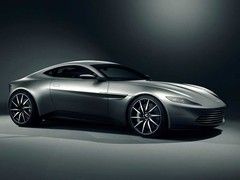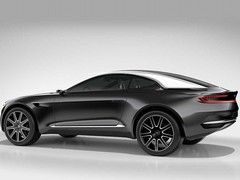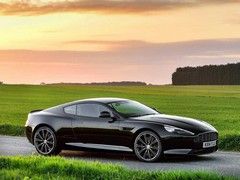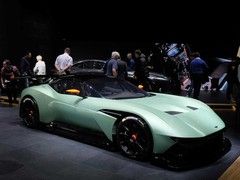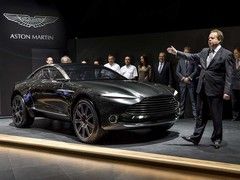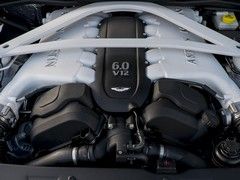Aston Martin's Andy Palmer: PH Meets
Aston's boss on new models, continued V12s and why we should never say 'VH architecture' again
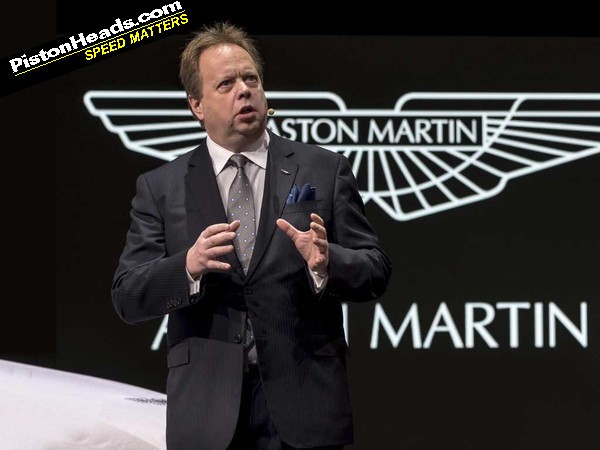
The man in question being Andy Palmer, six months into heading up Aston Martin having left the relative security of a senior corporate role as Nissan's global product supremo and now in charge of one of the most iconic sports car brands in the business. Yet despite Palmer's good spirits - and the presence of no fewer than four cars and concepts on the company's stand at Geneva - these are tough times at Aston. Sales have stagnated at around 4,000 a year, well below the 7,000 peak enjoyed before the global financial crash, and although a deal has been struck to deliver some much needed development funds, and a technical partnership entered with Daimler, the next-generation models are still more than a year away.
Let's start with that. Palmer is refreshingly willing to discuss the company's future model strategy, confirming that we'll see the replacement for the DB9 first - arriving in around 18 months time. This will, you won't be surprised to hear, share much of its design with the DB10 that's been created for 007's next romp. And it will also stick with V12 power, with Palmer confirming he's signed off on the development of a motor capable of passing increasingly strict emissions standards on both sides of the Atlantic.
Saints and sinners
"One of the reasons for having an electric car [the DBX concept, which we'll get onto later] is to allow me to continue with the V12 for longer," he told us, "of course, we've got to make it emissions compliant - the current V12 has to be completely renewed. But yes, we will have a 12-cylinder engine in our future, our customers demand that."
And it's necessary too. The only engine included in the technical partnership with Daimler is AMG's new twin-turbocharged V8, so to continue with the dozen-pot is a major ongoing commitment. And ensuring it can deliver more performance than the blown V8 will be a major challenge too, especially as we believe it will be sticking with natural aspiration.
The first V8 engined car will be the replacement for the Vantage, which will follow about six months behind the new DB9, with the Vanquish some way beyond that. To fill the gap before then Aston will continue to produce far more limited run 'specials', with Palmer aiming for at least two a year (an idea apparently vindicated by the popularity of the track-only Vulcan.)
For the new cars, engine choice will be limited to eight-, twelve- or - if Palmer gets his way - no cylinders, with no plans to downsize any time soon, or even to offer hybrid systems. The green bit will effectively be done by the production electric model hinted at by the DBX concept.
"There's an inevitability to having a hybrid because the car itself has to meet the standards as well as the total fleet... eventually that will mean some kind of hybridisation," he said, "there's an inevitability to downsizing too on the same timescale, and although I'd say a six-cylinder engine is possible - Aston has done them before - I'm not planning anything smaller than a V8."
"A lot of bulls**t"
The new cars will continue to be constructed using Aston's familiar combination of bonded and cast aluminium - or what we've previously always known as 'VH' architecture. Mentioning this by name sees Palmer lose his smile for the only time during the whole interview.
"There's a lot of bulls**t around the whole platform nomenclature to be frank," he says, frankly, "technically there's zero carry-over between the existing platform and the new platform - well, a single part... The VH platform was ahead of its time, it's what everyone is now doing. It should have been described as modular architecture, like MQB or one of the other systems big manufacturers have adopted. We're always having to make excuses for it being an old platform, but if you compare the original to today's there's been an enormous transformation, and it's a great way to build cars in the volumes we do. We just haven't told that story well."
More good news - the manual gearbox is also safe on Palmer's watch, he even admits that he would love Aston to be the last sports car maker to be offering three pedals and a do-it-yourself shifter, reckoning it will be no problem to mate this to the Daimler V8 (despite the obvious fact AMG doesn't offer it on the C63 or GT). "Even as the industry moves to twin-clutch transmissions, at the heart of each of those you still have a manual transmission. It's only a matter of breaking it into parts. And that's where I started my career of course, as a transmission engineer."
Which is also a broad hint in there that Aston will move to standardise its non-manual transmission option as a twin-clutcher instead of the current split between an automated single clutch on the Vantage and a torque converter 'box on the DB9 and Vanquish.
Shared strength
The other side of the deal with Daimler - to share electronic architecture - will provide just as much value to Aston as the V8 engine will, allowing the company to incorporate active safety features (and even - further forwards - even autonomous control) without incurring the massive costs of having to develop their own systems. And yes, we're promised the dreadfully dated sat nav systems of the current cars will be replaced by something far more modern on the next generation.
Bringing us back to the DBX - that electric 'crossover' concept that looked like a Vantage been cross-bred with a compact SUV. Yes, it's serious, and yes, if it does make production, it will be with an electric-only powertrain. This helps to offset the CO2 emissions of the rest of the range (the same argument once made for the completely unmourned Cygnet), but it's also designed to bring some new blood to the brand.
"When you think of the alternatives to a V8 or V12 I figured that the best alternative was the other extreme, silence," Palmer said, "you get a different kind of visceral experience when you do that, especially with the torque and response of an electric powertrain. We could have downsized, but I'd far rather keep the V12s and V8s for longer and at the other end basically offset to zero emissions with the electric powertrain."
Of course, whether you think Aston should be producing an electron-fuelled almost-SUV is another matter, but Palmer is adamant the company needs a model that will appeal to both developing markets and to buyers away from Aston's current demographic.
"In 102 years of history we've only sold 70,000 cars," he states, bluntly. "Of those, 3,500 went to women and 2,000 went into the BRICS countries [Brazil, Russia, India, China and South Africa]. So think about the opportunity going forward if you make a car that's approachable by women and the BRICS - with China the obvious proxy for that. You can imagine the opportunity we have."
Gassing Station | General Gassing | Top of Page | What's New | My Stuff

